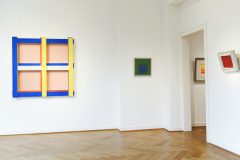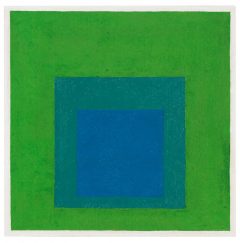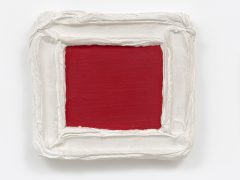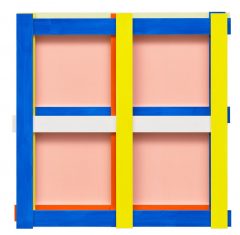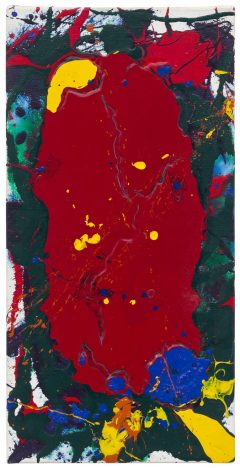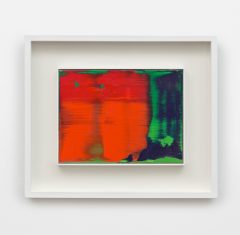Masterpiece Online
Due to the Corona pandemic, the Masterpiece London will take place as a pure online exhibition this year. The art fair has not only launched a new website for this purpose, but has also developed a versatile concept that brings galleries and visitors together. In various video formats, gallery owners present their highlights, share interesting backgrounds about the artists' work and invite you to virtual tours in their galleries. It is worth browsing the website of the fair. Click here for the Masterpiece Online.
The Physical Nature of Painting
Ludorff gallery is pleased to present a selection of six works by key post-war artists that have shaped the landscape of painting since 1945 until today: Josef Albers, Sam Francis, Heinz Mack, Bram Bogart, Imi Knoebel and Gerhard Richter have been and are essential innovators in an era who have challenged and pushed the limitations of painting. Their work is deeply rooted in the history of art and refers to the work of artists like Piet Mondrian and Kazimir Malevich, who had already defined endpoints of a potential development within the abstract world. Nevertheless the artists mentioned have overcome this point by incorporating new techniques, by opening up painting to the third dimension and by stimulating our minds with important intellectual concepts that have never been thought of before.
Werke
Josef Albers, German-American painter, art pedagogue, and teacher at the Bauhaus, emigrated to the USA after the National Socialists seized power in Germany and the Bauhaus closed in 1933. Albers took up a teaching post at the Black Mountain Collage. Influenced by the movement of Dutch "De Stijl" to the development of the "Abstract painting", he dealt with his perceptual theoretical considerations and contributions to color theory in painting through variations of the "Hommage to the Square" as well as with writing. His work in Abstract and Concrete Art had a great influence on the emergence of American color field painting and Op-Art. His students include Robert Rauschenberg and Richard Serra.
For Bram Bogart, color as physical matter and the material possibilities of the medium were the focus of his work. The mass of paint functioned as an indicator of physical activity, which was pushed, drawn or dragged across the canvas. Thus, starting from his early figurative painting, through abstract cubistic-geometric and gestural works, he developed his key period, in which he brought more and more colored paint material onto the canvas. His works exhibited at the Venice Biennale in 1970 are impressive examples of this. He visually softened the edges of these sculptural paintings or gave them a broad outline, the material of which often protruded beyond the boundary between the picture and its surroundings, emphasizing it and showing its importance for the artist. Through this demarcation, the work also becomes a refuge where the viewer can enjoy a sense of calm. In addition, the color fields and accumulations convey an idea of "building" with color and illustrating a seamless cohesion of color, gesture and structure.
The painter and sculptor Imi Knoebel, born in 1940 in Dessau, studied the methods of structural and constructive composition at the Werkkunstschule Darmstadt before studying under Joseph Beuys at the Art Academy in Düsseldorf. Influenced by the works of Piet Mondrian and Kasimir Malewitsch, he uses a puristic-geometric design language and meticulously coordinated color shades, which are usually detached from common color principles to stand for themselves. Through the three-dimensionality in the layering of materials and color fields, his works not only arouse associations with sculpture and installation, but also thematise sensory experience as such. To this end, Knoebel condenses form tension and color saturation to the highest intensity and creates individual worlds of imagination on the part of the observer through the visual exploration of their interplay.
The U.S. American painter Sam Francis is one of the most important representatives of Abstract Expressionism following a second generation of artists such as Jackson Pollock, Mark Rothko or Willem de Kooning. His frequent travels between New York, California, Europe - especially Paris -, Mexico, and Japan made their mark on his oeuvre, freeing him at the same time to be perceived as a strictly American artist. Influenced by European Art Informel and Zen Buddhism, Francis developed an oevure that sought to unite the idea of emptiness with the presence of a painterly presence. In this way Francis combines influences from caligraphy, colour field painting and action painting in his works, where pure colours meet unpainted surfaces and increase each other's effect.
Born in Dresden in 1932, the painter, sculptor and photographer Gerhard Richter first studied at the Dresden Academy of Arts before fleeing to West Germany in the early 1960s to eventually continue his studies at the Düsseldorf Art Academy. Influenced by post-war abstraction, he began working intensively on abstract painting towards the end of the 1960s. Initially, however, he only created portraits and still lives based on photographs which, through their specific image detail and blurring, alienate reality. From the 1970s on he proclaimed the power of chance as an artistic method in his work and applies it in the medium of watercolor painting as well as canvas painting on large and small formats. The layering and the way in which colors are applied play a decisive role here: sharp color contrasts meet fine color gradations and overlays, which challenge one to examine the image structure more closely.
Light gives the room its sensuality, its atmosphere, its transparency. (H. M., 1961)
In 1957 Heinz Mack and Otto Piene founded the ZERO movement, which aims to mark a zero point and a new beginning in art. 1961 Günther Uecker joins the movement. The traditional understanding of art was to be overcome. Mack experimented with light and movement, partly directly in untouched nature. He understands "colour as light and light as colour". His non-objective sculptures, works on paper and paintings follow the same principle: since 1991, "Chromatic Constellations" have been created from pure color, visualizing the oscillations and dynamics between individual color levels. The delineated forms create a rhythm in the works. His sculptures and reliefs are also characterized by the powerful combination of light and movement. Mack himself describes drawings as "grammar of my art" and "language of his hand".
